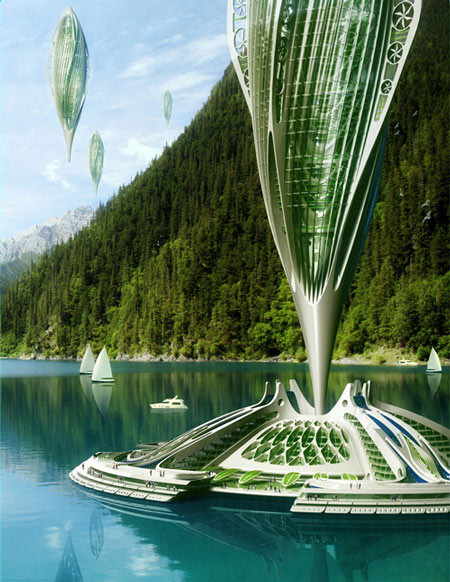
Close to a year ago, we reported on Callebaut’s radical idea for a vertical farm situated on the south edge of Roosevelt Island, New York. It is nice to see that Callebaut’s latest project, Hydrogenase still offers the same dynamic result, but this time, instead of addressing the food shortage issue, it aims to create a self-sufficient organic airship. This conceptual transport system would be comprised of airships that produce biofuel from seaweed. The project draws its inspiration from nature, as well as from the qualities of its materials and its self-manufacturing processes.
More about the project after the break.
The vertical aircraft will be inhabitated and provides “a clean and ethic mobility to meet the needs of the population en distress touched by the natural and sanitary catastrophes, and all that without any runway. Its architecture is subversive and fundamentally critic towards the ways of living of our contemporary society that we have to reinvent totally.”
Callebaut also conceived various generations of the Hydrogenase that will be released in 2015, 2020, and 2030 – each with more advancements and striving to become a 100% self-sufficence organic airship. In 2015, it creates a sustainable mobility sector, in 2020, it moves toward an aerial revolution and generation of airships, in 2030, the project aims to become the self-sufficient airship.

The Hydrogenase of 2030 will question “our frenetic society and think differently to the mobility and services.” The inhabited vertical airship will reload directly with bio-hydrogen. With two interdependent entities, one flies in the sky and the second one on the seas and oceans.

The ship that flourishes in the air seems like a big flower ready to open as the spaces divide in cross under the shape of petals. The spaces are designed for housing, offices, scientific laboratories and entertainment. The steam around these petals form the vertical circulations, the technical premises and the goods warehouses for the freight.

These 4 inhabited spaces are included between 4 great bubbles inflated with bio-hydrogen, a renewable energy. These bubbles are made with a rigid hull in light alloy shaped with twisted longitudinal beams linked together by wide sinusoidal rings. The floating organic farm is a true organic purifying station composed of 4 carbon wells in which the green seaweeds recycle our carbonated waste brought by ships. This is directly dedicated to feed organically in biohydrogen the proactive airship. It replaces thus the petrol station as the runway for traditional airplanes and looks like a weaving of fine amphibian laces.

Read more about the project and view more images on the architect’s website. All material courtesy of Vincent Callebaut Architects.





















